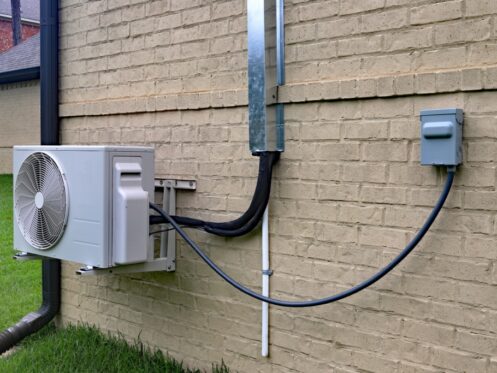Mini-splits are heating and cooling systems that provide zoned climate control for individual rooms or spaces. They consist of two main components: an outdoor compressor or condenser unit and one or more indoor air-handling units. Unlike central air conditioning systems, mini-splits do not require ductwork to distribute air throughout a building.
How Do Mini-Splits Work?
Mini-split systems include two main components: an outdoor unit and one or more indoor units. These units are connected by a refrigerant line, eliminating the need for ductwork. The outdoor unit contains the compressor and condenser, while the indoor unit houses the evaporator and blower.
When the indoor unit detects the desired temperature set by the user, it sends a signal to the outdoor unit to start the compressor. The compressor pressurizes the refrigerant and sends it to the indoor unit, where it enters the evaporator coil. As the warm air from the room flows over the coil, the refrigerant absorbs the heat, turning it into a gas. The cool air is then circulated back into the room by the blower, providing the desired temperature.
For the hot refrigerant gas, travels back to the outdoor unit through the refrigerant line. Then, the heat is expelled as the gas passes through the condenser coil. The refrigerant then condenses into a liquid and returns to the indoor unit to repeat the cycle.
This continuous process allows mini-splits to efficiently cool or heat individual rooms or zones without the energy losses associated with traditional ducted systems. Moreover, the absence of ductwork reduces the risk of air leaks, ensuring better energy efficiency and indoor air quality.
What You Should Know Before Installing a Mini-Split
When considering the installation of mini-splits, several factors should be taken into account. Firstly, it is crucial to assess your specific cooling and heating needs. Mini-split systems are highly efficient and offer zone-based temperature control, but it’s important to ensure that they are suitable for the size and layout of your space.
Assess the number of rooms or zones you want to cool or heat, and consider the square footage of each area. This will help determine the number and capacity of mini-split units required for your installation. Consulting with our professional HVAC technicians can provide valuable insights and help ensure that you choose the right system for your needs.
Secondly, it’s essential to consider all the installation requirements and constraints. Mini-split systems consist of an outdoor condenser unit connected to one or more indoor air-handling units via refrigerant lines. Installation involves drilling holes, running refrigerant lines, and wiring connections, which may require professional expertise.
Additionally, the location of the indoor units should be carefully chosen to maximize efficiency and comfort. Factors such as wall or ceiling height, furniture placement, and proximity to electrical outlets should be considered. Lastly, proper installation is key to achieving optimal performance and ensuring the longevity of your mini-split system.
Why You Should Seek Professional Help When Installing a Mini-Split
When installing a mini-split unit, professional help is highly recommended for several reasons. Firstly, our professional technicians from Blue Best Plumbing, Heating, Air, & Generators have the expertise and experience to ensure the installation is done correctly. Our team is knowledgeable about the intricacies of mini-split systems and can handle the complex tasks involved, such as refrigerant line installation, electrical connections, and system testing.
Secondly, we can guarantee compliance with building codes and regulations. HVAC installations often involve specific requirements set by local authorities to ensure safety and efficiency. Our technicians are well-versed in these codes and regulations and can ensure that your mini-split installation meets all the necessary standards. By relying on us, you can have peace of mind knowing that your installation is compliant with the relevant guidelines and that your system operates safely.
Do Mini-Splits Require Regular Service?
While mini-splits are known for their efficiency and durability, neglecting routine maintenance can lead to various issues. Regular service helps to keep the system running smoothly and efficiently. It involves cleaning or replacing the air filters, inspecting and cleaning the evaporator and condenser coils, checking refrigerant levels, and verifying the overall system performance.
By adhering to a regular service schedule, you can prevent dust and debris buildup, improve indoor air quality, maximize energy efficiency, and avoid potential breakdowns or costly repairs in the long run. Besides, routine service by our professional technicians can detect any underlying issues early on and address them promptly, ensuring the system’s reliability and prolonging its life span.
Moreover, regular servicing of a mini-split unit is crucial for maintaining indoor air quality and preventing health issues. Over time, dirt, allergens, and pollutants can accumulate in the filters and coils of the system, reducing its ability to filter the air effectively. This can lead to poor indoor air quality and exacerbate allergies or respiratory problems.
By scheduling regular service with us, our technicians can thoroughly clean and inspect the system, ensuring it operates efficiently and provides clean and healthy air. Regular maintenance not only extends the life span of the mini-split system but also enhances its performance, saves energy, and promotes a healthier living environment for occupants.
When You Should Consider Replacing Your Mini-Split
One key factor to consider is the age of your mini-splits. Generally, these systems have a life span of around 12 to 15 years. If your units are reaching or have surpassed this age range, it might be a good idea to explore replacement options. Older systems are more prone to breakdowns and may not provide the same level of energy efficiency as newer models, resulting in higher utility bills. Additionally, technological advancements have led to the development of more advanced mini-split systems that offer improved performance and energy-saving features.
Another consideration for replacement is the frequency and cost of repairs. If you find yourself constantly calling for repairs or if the repair costs are becoming increasingly expensive, it may be more cost-effective to replace the entire system. Ongoing repairs can add up quickly and could eventually exceed the cost of a new mini-split installation.
Also, newer models come with warranties that provide added peace of mind and protection against unexpected repair expenses. By replacing your mini-split in such circumstances, you can ensure a more efficient and reliable cooling system while potentially saving money in the long run.
Ultimately, proper installation, maintenance, and regular service are all factors when it comes to evaluating the effectiveness of your mini-split system. If you are unsure where to begin, however, our technicians will guide you all the way.
In addition to mini-split systems, all of our technicians also have tons of experience providing furnace repair and replacement, heat pump installation, and AC installation and repair services to residents of the Greater Salt Lake City area and Wasatch Front region. At Blue Best Plumbing, Heating, Air, & Generators, we also offer indoor air quality solutions and HVAC maintenance plan services. Contact us today to find out more about our services.








